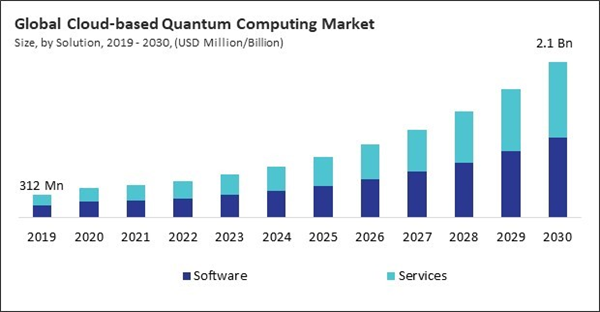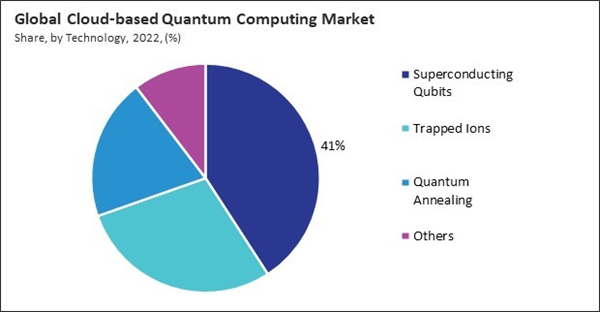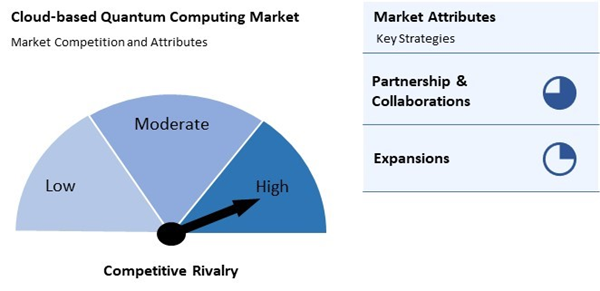The Global Cloud-based Quantum Computing Market size is expected to reach $2.1 billion by 2030, rising at a market growth of 19.9% CAGR during the forecast period.
The aerospace and defense sector places a high premium on communication security, and quantum computing holds promise for enhancing cryptographic methods. Consequently, the aerospace and defense segment captured $48.52 million revenue in the market in 2022. As per the International Trade Administration, the aerospace sector in the United Kingdom is export-driven and ranks second largest globally, after the United States. Civil aerospace revenue in the United Kingdom reached an estimated $34.5 billion in 2022. The defense industry achieved an approximate turnover of $29 billion in 2022, of which $15 billion was allocated for exports.
Ongoing research and development efforts have resulted in designing and fabricating more powerful and stable quantum processors. Progress in quantum software development includes the creation of quantum programming languages, compilers, and simulators. Quantum algorithms, tailored for specific applications, have been refined and optimized, demonstrating improved performance on evolving quantum hardware. Therefore, these aspects can lead to increased demand for cloud-based quantum computing.
Additionally, the escalating demand for quantum computing capabilities across a spectrum of industries underscores the transformative potential of quantum technology. The increasing number of Small and Medium Enterprises (SMEs) globally has been a notable trend in recent years. For instance, as per the data from Statistics Canada, small- and medium-sized businesses contribute significantly to the Canadian economy, making up 98.1% of all employer businesses in Canada in 2021.
However, by carrying out computations at speeds unmatched by classical computers, quantum computers utilize the principles of quantum mechanics. As the number of qubits and the intricacy of quantum algorithms increase, preserving the delicate quantum states necessary for computation becomes significantly more difficult. This sensitivity introduces a layer of complexity when deploying quantum computing services in the cloud. Thus, these factors can hamper the growth of the market.
The market is characterized by fierce competition among industry giants like IBM, Google, Microsoft, and Amazon, who are leveraging their resources and expertise to develop and commercialize quantum computing solutions. Startups are also entering the fray, contributing to innovation and disruption. Partnerships between academia and industry further fuel advancements, offering customers a plethora of options with distinct features and capabilities, while factors like performance, scalability, and pricing models shape purchasing decisions in this rapidly evolving landscape.
The aerospace and defense sector places a high premium on communication security, and quantum computing holds promise for enhancing cryptographic methods. Consequently, the aerospace and defense segment captured $48.52 million revenue in the market in 2022. As per the International Trade Administration, the aerospace sector in the United Kingdom is export-driven and ranks second largest globally, after the United States. Civil aerospace revenue in the United Kingdom reached an estimated $34.5 billion in 2022. The defense industry achieved an approximate turnover of $29 billion in 2022, of which $15 billion was allocated for exports.
Ongoing research and development efforts have resulted in designing and fabricating more powerful and stable quantum processors. Progress in quantum software development includes the creation of quantum programming languages, compilers, and simulators. Quantum algorithms, tailored for specific applications, have been refined and optimized, demonstrating improved performance on evolving quantum hardware. Therefore, these aspects can lead to increased demand for cloud-based quantum computing.
Additionally, the escalating demand for quantum computing capabilities across a spectrum of industries underscores the transformative potential of quantum technology. The increasing number of Small and Medium Enterprises (SMEs) globally has been a notable trend in recent years. For instance, as per the data from Statistics Canada, small- and medium-sized businesses contribute significantly to the Canadian economy, making up 98.1% of all employer businesses in Canada in 2021.
However, by carrying out computations at speeds unmatched by classical computers, quantum computers utilize the principles of quantum mechanics. As the number of qubits and the intricacy of quantum algorithms increase, preserving the delicate quantum states necessary for computation becomes significantly more difficult. This sensitivity introduces a layer of complexity when deploying quantum computing services in the cloud. Thus, these factors can hamper the growth of the market.
By Solution Analysis
Based on solution, the market is segmented into software and services. In 2022, the services segment garnered a 47.02% revenue share in the market. The intricate nature of quantum computing necessitates specialized expertise for effective implementation and utilization. Organizations, both large enterprises and smaller entities, are increasingly seeking services that provide expert consultation on quantum algorithms, programming, and optimization.By Technology Analysis
On the basis of technology, the market is divided into trapped ions, quantum annealing, superconducting qubits, and others. In 2022, the superconducting qubits segment witnessed the 40.82% revenue share in the market. Superconducting qubits have demonstrated remarkable performance characteristics, including high coherence times, low error rates, and scalability potential.By Application Analysis
Based on application, the market is divided into optimization, simulation & modelling, sampling, and others. In 2022, the simulation and modelling segment witnessed a substantial revenue share in the market. The material science sector has contributed significantly to the demand for quantum simulation and modeling.By Vertical Analysis
On the basis of vertical, the market is divided into aerospace & defense, BFSI, healthcare, automotive, energy & power, chemical, government, and others. The BFSI segment recorded the 28.85% revenue share in the market in 2022. Financial institutions leverage quantum computing to optimize investment portfolios and risk management strategies. Quantum algorithms can efficiently handle the complexities of large-scale financial data, providing faster and more accurate solutions for portfolio optimization.By Regional Analysis
By region, the market is segmented into North America, Europe, Asia Pacific, and LAMEA. In 2022, the Europe segment acquired a 28.78% revenue share in the market. Europe has a rich academic excellence and scientific research tradition, and the rising demand for cloud quantum computing is closely tied to collaborative efforts between universities, research institutions, and industry partners.Market Competition and Attributes
The market is characterized by fierce competition among industry giants like IBM, Google, Microsoft, and Amazon, who are leveraging their resources and expertise to develop and commercialize quantum computing solutions. Startups are also entering the fray, contributing to innovation and disruption. Partnerships between academia and industry further fuel advancements, offering customers a plethora of options with distinct features and capabilities, while factors like performance, scalability, and pricing models shape purchasing decisions in this rapidly evolving landscape.
Recent Strategies Deployed in the Market
- Jan-2024: IBM Corporation collaborated with Korea Quantum Computing (KQC), providing advanced AI, infrastructure, and quantum computing services. Through this collaboration, users access IBM's AI stack, including watsonx. KQC extends its quantum collaboration, offering access to IBM's global quantum systems. Additionally, plans entail deploying IBM Quantum System Two at KQC in Busan by 2028.
- Nov-2023: Microsoft Corporation partnered with Photonic Inc., a quantum technology startup from Vancouver, BC, Canada. Together, both companies will devise a quantum-networking plan, granting Microsoft access to Photonic's silicon-based quantum tech for its Azure cloud platform.
- Nov-2023: Terra Quantum AG partnered with NVIDIA to advance data analytics with hybrid quantum computing, aiming to boost business performance and insights. Through this partnership, both companies will jointly accelerate hybrid quantum integration via GPUs, leveraging NVIDIA CUDA Quantum platform for efficient execution of Terra Quantum applications.
- Jun-2023: IBM Corporation unveiled plans for its inaugural Europe-based quantum data center, aimed to providing widespread access to advanced quantum computing. Expected to launch in 2024 at IBM's Ehningen facility in Germany, it will house multiple utility-scale quantum processors surpassing 100 qubits each. Additionally, serving as IBM Quantum's European cloud region, the center will enable users globally to provision services for cloud-based quantum research and exploration.
- Mar-2023: Azure Quantum, Microsoft’s quantum cloud computing service announced a partnership with HCL Technologies. Through this partnership, HCL will provide clients with cloud-based quantum computing services using Microsoft's platform as the technology stack. Additionally, services will be available through HCLTech's Q-Labs, already an Azure Quantum credits partner.
List of Key Companies Profiled
- Google LLC (Alphabet Inc.)
- Microsoft Corporation
- IBM Corporation
- Amazon Web Services, Inc. (Amazon.com, Inc.)
- Baidu, Inc.
- Huawei Technologies Co., Ltd. (Huawei Investment & Holding Co., Ltd.)
- Terra Quantum AG
- SpinQ Technology Co., Ltd.
- QpiCloud Techonologies
- CERN
Market Report Segmentation
By Solution- Software
- Services
- Superconducting Qubits
- Trapped Ions
- Quantum Annealing
- Others
- Optimization
- Simulation & Modelling
- Sampling
- Others
- BFSI
- Healthcare
- Automotive
- Energy & Power
- Aerospace & Defense
- Government
- Chemical
- Others
- North America
- US
- Canada
- Mexico
- Rest of North America
- Europe
- Germany
- UK
- France
- Russia
- Spain
- Italy
- Rest of Europe
- Asia Pacific
- China
- Japan
- India
- South Korea
- Singapore
- Malaysia
- Rest of Asia Pacific
- LAMEA
- Brazil
- Argentina
- UAE
- Saudi Arabia
- South Africa
- Nigeria
- Rest of LAMEA
Table of Contents
Chapter 1. Market Scope & Methodology
Chapter 2. Market at a Glance
Chapter 3. Market Overview
Chapter 5. Global Cloud-based Quantum Computing Market by Solution
Chapter 6. Global Cloud-based Quantum Computing Market by Technology
Chapter 7. Global Cloud-based Quantum Computing Market by Application
Chapter 8. Global Cloud-based Quantum Computing Market by Vertical
Chapter 9. Global Cloud-based Quantum Computing Market by Region
Chapter 10. Company Profiles
Companies Mentioned
- Google LLC (Alphabet Inc.)
- Microsoft Corporation
- IBM Corporation
- Amazon Web Services, Inc. (Amazon.com, Inc.)
- Baidu, Inc.
- Huawei Technologies Co., Ltd. (Huawei Investment & Holding Co., Ltd.)
- Terra Quantum AG
- SpinQ Technology Co., Ltd.
- QpiCloud Techonologies
- CERN
Methodology

LOADING...











